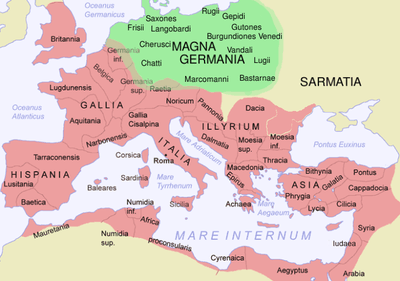Barbaricum

Barbaricum is a geographical name used by historical and archaeological experts to refer to the vast area of barbarian-occupied territory that lay, in Roman times, beyond the frontiers or limes of the Roman Empire in North, Central and South Eastern Europe,[1] the "lands lying beyond Roman administrative control but nonetheless a part of the Roman world."[2] In the Late Antiquity it was the Latin name for those tribal territories not occupied by Rome that lay beyond the Rhine and Danube (but not for Persia): Ammianus Marcellinus used it,[3] as did Eutropius.[4] The earliest recorded mention appears to date to the early 3rd century.[5]
In the research literature, the terms 'Germania' (which actually means Germania Magna) and 'Barbaricum' are sometimes used interchangeably, but they are not entirely identical either in the chronological or in the geographical sense.[6] The extra-Roman area described as Barbaricum was, from the beginning of the Migration Period, not exclusively inhabited by Germanii, even though they represented the majority of the population until the time of Late Antiquity. In the Migration Period, Alans and Huns also pushed forward into this area before and, later (from the 6th century), Slavic tribes populated the area east of the Albis (River Elbe) that the Germanii had largely abandoned.[7]
It is important to highlight the diverse cultural, social and economic contacts between (Germanic) Barbaricum and the Empire since the early imperial period. Archaeologically, numerous imported Roman artefacts have been uncovered among the finds in the Barbaricum region.[8] The formation of major Germanic tribal units such as the Alemanni and Franks, from the time of the imperial crisis of the 3rd century was probably influenced by contact with the Roman world. Likewise, "barbarians" were able to have careers in the Roman Army.
References
- ↑ Grane, Thomas. Beyond the Roman Frontier: Roman Influences on the Northern Barbaricum. Quasar, 2007, p. 5. ISBN 978-8-87140-346-5.
- ↑ Burns, Thomas S. Rome and the Barbarians, 100 B.C.-A.D.400. Baltimore and London: John Hopkins, 2003, p. 35.
- ↑ See e.g. Ammianus 18,2,14: in barbarico
- ↑ Hubert Fehr, Philipp von Rummel: Die Völkerwanderung. Theiss Wissen Kompact, Stuttgart, 2011, p. 30; Eutropius 7.9: trans Albim fluvium [...], qui in Barbarico longe ultra Rhenum est ( over the Elbe, which is in the barbarian land far beyond the Rhine)
- ↑ Tadeusz Sarnowski: Barbaricum und ein bellum Bosporanum in einer Inschrift aus Preslav. In: Zeitschrift für Papyrologie und Epigraphik 87 (1991), pp. 137–144, here p. 143.
- ↑ In Polish archaeological research, for example, the area designated as 'Barbaricum' extends much further east than can be reconciled with the tribal area of the Germanii, c.f. Rosemarie Müller: Reaktionen auf die Gleichung germanisch-deutsch im östlichen Mitteleuropa. In: Heinrich Beck (ed.): Zur Geschichte der Gleichung "germanisch-deutsch". Berlin, 2004, pp. 265ff, here p. 269. For the meaning of the term, see also Ulla Lund Hansen: Römische Kaiserzeit. In: Reallexikon der Germanischen Altertumskunde. Vol. 25 (2003), pp. 90ff., Here p.90.
- ↑ On the Migration Period c.f. the current overview by Guy Halsall: Barbarian Migrations and the Roman West, 376–568. Cambridge, 2007.
- ↑ See Hans Jürgen Eggers. Der römische Import im freien Germanien. Atlas Urgesch. 1, Hamburg, 1951; Siegmar von Schnurbein: Vom Einfluß Roms auf die Germanen. North Rhine-Westphalian Acad. of Science. Lectures G 331. Opladen 1995; Siegmar von Schnurbein, M. Erdrich: Das Projekt: Römische Funde im Mitteleuropäischen Barbaricum, dargestellt am Beispiel Niedersachsen. Roman-Germanic Commission report no. 73, 1992, pp. 5-27
Literature
- Heinrich Beck (ed.): Zur Geschichte der Gleichung "germanisch-deutsch". Berlin, 2004.
- Hans Jürgen Eggers: Der römische Import im freien Germanien. Atlas Urgesch. 1, Hamburg, 1951.
- Guy Halsall: Barbarian Migrations and the Roman West, 376–568. Cambridge, 2007.
- Gustav Adolf Lehmann: Imperium und Barbaricum. Neue Befunde und Erkenntnisse zu den römisch-germanischen Auseinandersetzungen im nordwestdeutschen Raum – von der augusteischen Okkupationsphase bis zum Germanien-Zug des Maximinus Thrax (235 n. Chr.). Vienna, 2011.
- Ulla Lund Hansen: Römische Kaiserzeit. In: Reallexikon der Germanischen Altertumskunde. Vol. 25 (2003), pp. 90ff.
- Walter Pohl: Die Germanen. 2nd edn. Munich, 2004.
- Tadeusz Sarnowski: Barbaricum und ein bellum Bosporanum in einer Inschrift aus Preslav. In: Zeitschrift für Papyrologie und Epigraphik 87 (1991), pp. 137–144.
- Helmuth Schneider (ed.): Feindliche Nachbarn. Rom und die Germanen. Böhlau Verlag, Cologne, 2008, ISBN 978-3-412-20219-4.
External links
| Look up Barbaricum in Wiktionary, the free dictionary. |